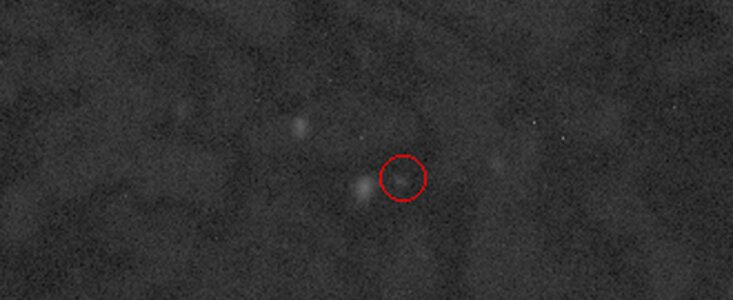NOAO: Student’s Work Helps to Detect Near Earth Asteroids
20 Noviembre 2011
An asteroid impact with the earth can really ruin your day: just consider the dinosaurs. Most asteroids, also known as minor planets, orbit the sun beyond the planet Mars and present no danger, but there is a class of asteroids whose orbits cross the orbit of the earth. If one of these asteroids and the earth are at the same point in their orbits at the same time, a collision could occur. Called Near Earth Objects (NEOs), astronomers are interested in discovering as many of these as possible, and then tracking them in order to compute more accurate orbits. In this way, if a potential future collision were to be identified many years in advance, space probes could carry out steps to tweak the path of the NEO and deflect the collision. A program to track NEOs is being carried out at NOAO by Mark Trueblood with Robert Crawford (Rincon Ranch Observatory) and Larry Lebofsky (Planetary Science Institute). And last summer, a Beloit College student, Morgan Rehnberg, has developed a computer program (PhAst), available via the web, to help with this effort.
An asteroid impact with the earth can really ruin your day: just consider the dinosaurs. Most asteroids, also known as minor planets, orbit the sun beyond the planet Mars and present no danger, but there is a class of asteroids whose orbits cross the orbit of the earth. If one of these asteroids and the earth are at the same point in their orbits at the same time, a collision could occur. Called Near Earth Objects (NEOs), astronomers are interested in discovering as many of these as possible, and then tracking them in order to compute more accurate orbits. In this way, if a potential future collision were to be identified many years in advance, space probes could carry out steps to tweak the path of the NEO and deflect the collision. A program to track NEOs is being carried out at NOAO by Mark Trueblood with Robert Crawford (Rincon Ranch Observatory) and Larry Lebofsky (Planetary Science Institute). And last summer, a Beloit College student, Morgan Rehnberg, has developed a computer program (PhAst), available via the web, to help with this effort.
Asteroids move quickly across the sky, so in order to recover and track them, fast and accurate data reduction and analysis is essential. Unlike most of the data that astronomers work with, tracking a fast moving asteroid requires that the observer view multiple digital images obtained at the telescope by blinking between them, almost like a movie. In addition, accurate coordinates locating the NEO in the sky need to be computed. (Termed right ascension and declination, these are similar in concept to the latitude and longitude of a position on earth.) While there are many software packages that amateur and professional astronomers use (Maxim DL, Astrometrica) none did exactly what the group required. Seeing the need for better software but not having the time to devote to the task of writing it, Trueblood saw this as an ideal project for a summer student.
The National Optical Astronomy Observatory (NOAO) has a long history of hiring college students for the summer. Through this Research Experience for Undergraduates (REU) program, supported by the National Science Foundation, undergraduates learn what an astronomical career is really like. Many of these students go on to become professional astronomers after a summer spent at the National Observatory. Morgan Rehnberg, who attends Beloit College in Wisconsin, had the required computer skills and was selected to work in the very competitive REU program by Mark Trueblood, Ken Mighell, and Robert Crawford. His task involved modifying an existing image viewer program (ATV, written in the code IDL) so that it could examine as many images as desired, and in any order, and perform the astrometric (positional) as well as photometric (brightness) analyses.
Although Morgan tested his new software on existing data, the first actual trial occurred in October, during an observing run at the 2.1m telescope at Kitt Peak National Observatory. The group observed a Potentially Hazardous Asteroid (PHA), designated NEO2008 QT3: these are asteroids with orbits that bring them within 50,000 km of the earth (the earth-moon distance is about 385,000 km). Morgan’s software program was able to correctly compute the position and brightness of this object with half the measurement errors in the previous software. The results were submitted and accepted by the clearinghouse for all such observations, the Minor Planet Center.
Más Información
Named PhAst (for Photometry and Astrometry), the computer program is available at http://www.noao.edu/noao/staff/mighell/phast/ . In addition to the multi-object support, it contains the ability to calibrate images, perform astrometry (using the existing open source packages SExtractor, SCAMP, and missFITS), and construct the reports for the Minor Planet Center.
NOAO is operated by Association of Universities for Research in Astronomy Inc. (AURA) under a cooperative agreement with the National Science Foundation.
Contactos
Mark Trueblood
Project Manager NOAO System Technology Center National Optical Astronomy Observatory
950 N. Cherry Ave. Tucson, AZ 85719, USA
Tel: +1 520 318 8519
Correo electrónico: mtrueblood@noao.edu




